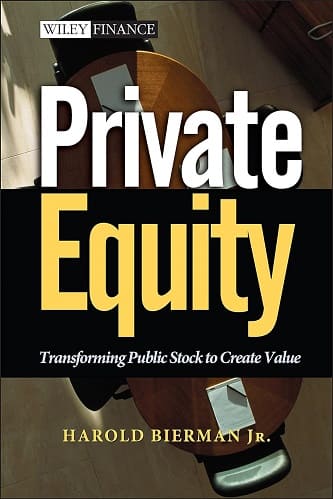Private Equity: Transforming Public Stock to Create Value
$29.89
| Author(s) | |
|---|---|
| Format |
|
| Pages |
204 |
| Publication Year |
2003 |
Private Equity: Transforming Public Stock to Create Value thoroughly explores private equity capital and its advantages, both financial and operational. Financial expert Harold Bierman Jr. takes an in-depth look at private equity and helps you gain a firm understanding of it from both a managerial and investment standpoint.
Introduction:
Private equity frequently is associated with a leveraged buyout. The equity ownership of a public corporation is changed to equity that is not traded in a public market. There are significant financial advantages and there are also operational advantages. For example, management frequently becomes an owner of a significant amount of the equity and thus the interests of management and the owners become more convergent. Most importantly, the common stock-holders can directly and effectively affect the corporate financial decisions.
The concepts of this book are important to investors interested in increasing their rates of return on their investments, without increasing their risk and to management interested in supplementing their wages with a significant share of the firm’s profitability.
For purposes of this book the term private equity refers to the common stock of a corporation where that common stock is held by a relatively few investors and is not traded on any of the conventional stock markets. Normally the senior managers of the firm hold a significant percentage of the firm’s stock, and we will assume that is the situation in all the cases discussed in this book. In practice, the term private equity is used in several different ways. There are private equity investment firms that direct their clients’ funds into mutual funds or to other money managers. There are even private equity funds that invest directly into publicly owned corporations, usually concentrating the investments into a few corporations.
Venture capital is a form of private equity. In this book the use of the term will be restricted to the investment in the equity of corporations that are, or will soon be, not publicly owned. An exception is the case of a partial leveraged buyout (LBO). This is almost private equity but the firm is still publicly traded. Megginson, Nash, and vanRadenborgh (1996) offer a review of the history of privatization. Jensen (1993) covers the general issue of corporate control. Kleiman (1988) studied and reports the gains from LBO types of transactions.
Contents:
- The Many Virtues of Private Equity
- Valuing the Target Firm
- Structuring and Selling the Deal
- A Changed Dividend Policy
- A Changed Capital Structure
- Merchant Banking
- Operations: The Other Factor
- The Many Virtues of Going Public
- A Partial LBO: Almost Private Equity
- Metromedia (1984)
- LBO of RJR Nabisco (1988)
- Marietta Corporation (1994-1996)
- The Managerial Buyout of United States Can Company (2000)
- Phillips Petroleum, Mesa, and Icahn (1984-1985)
- Owens-Corning Fiberglas Corporation (1986)
Private Equity: Transforming Public Stock to Create Value By Harold Bierman pdf
2 reviews for Private Equity: Transforming Public Stock to Create Value
Clear filtersOnly logged in customers who have purchased this product may leave a review.










Willa Hayden (verified owner) –
I recently purchased this book and I must say I’m impressed with its content. The author has done a great job of explaining complex concepts in a simple and easy-to-understand manner.
The book covers a wide range of topics related to private equity, including deal sourcing, due diligence, valuation, and exit strategies. It also includes real-world case studies and examples that help illustrate the concepts discussed.
One thing I particularly liked about this book is that it provides practical advice and insights that can be applied in real-life scenarios. Whether you’re a seasoned PE professional or just starting out, this book is a valuable resource that can help you enhance your knowledge and skills.
Overall, I would highly recommend this book to anyone looking to learn more about private equity. It’s well-written, informative, and provides a comprehensive overview of the industry.
Leroy Frye (verified owner) –
I bought this book hoping that it would, through a good mix of principles and case studies, help me understand the private equity industry betther. The book does not live up to these expectations.
First, it is written badly, and seems more a series of preliminary notes than a well thought out book. Discussions are short and often repetitive. The analytics are extremely simplistic and are essentially a regurgitation of elementary finance theory (things like valuing a company with a fixed dividend growth rate). There is very little in them that is specific to private equity.
The book gives the reader absolutely no sense of what makes private equity different from other forms of finance, or the history and prospects of the industry. A quick review of the bibliography suggests that most of what the author has to say is already outdated and irrelevant.
I wouldn’t want someone else to waste his or her time with it (let alone his/her money)! A much better book is Venture Capital & Private Equity by Lerner and Hardymon.